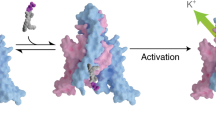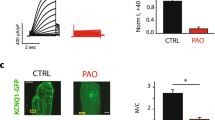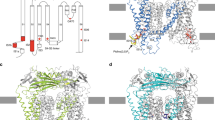Abstract
Anionic phospholipids (APs) present a variety of lipids in the cytoplasmic leaflet of the plasma membrane, including phosphatidylinositol (PI), PI-4-phosphate (PI(4)P), phosphatidylserine (PS), PI-4,5-bisphosphate (PI(4,5)P2), PI-3,4,5-trisphosphate (PI(3,4,5)P3), and phosphatidic acid (PA). We previously showed that PI(4,5)P2 and PI(3,4,5)P3 upregulate the renal epithelial sodium channel (ENaC). Further studies from others suggested that PI(4,5)P2 and PI(3,4,5)P3 respectively target β- and γ-ENaC subunit. To determine whether PI(4,5)P2 and PI(3,4,5)P3 selectively bind to β and γ subunit, we performed lipid-protein overlay experiments. Surprisingly, the results reveal that most APs, including PI(4)P, PS, PI(4,5)P2, PI(3,4,5)P3, and PA, but not PI, non-selectively bind to not only β and γ but also α subunit. To determine how these APs regulate ENaC, we performed inside-out patch-clamp experiments and found that PS, but not PI or PI(4)P, maintained ENaC activity, that PI(4,5)P2 and PI(3,4,5)P3 stimulated ENaC, and that PA, however, inhibited ENaC. These data together suggest that APs differentially regulate ENaC by physically interacting with α-, β-, and γ-ENaC. Further, the data from cell-attached patch-clamp and confocal microscopy experiments indicate that PA, a product of phospholipase D, may provide one of the pathways for inhibition of ENaC by endothelin receptors.







Similar content being viewed by others
References
Ambar I, Sokolovsky M (1993) Endothelin receptors stimulate both phospholipase C and phospholipase D activities in different cell lines. Eur J Pharmacol 245:31–41
Baldi E, Musial A, Kester M (1994) Endothelin stimulates phosphatidylcholine hydrolysis through both PLC and PLD pathways in mesangial cells. Am J Physiol 266:F957–F965
Bao HF, Zhang ZR, Liang YY, Ma JJ, Eaton DC, Ma HP (2007) Ceramide mediates inhibition of the renal epithelial sodium channel by tumor necrosis factor-α through protein kinase C. Am J Physiol 293:F1178–F1186
Baukrowitz T, Schulte U, Oliver D, Herlitze S, Krauter T, Tucker SJ, Ruppersberg JP, Fakler B (1998) PIP2 and PIP as determinants for ATP inhibition of KATP channels. Science 282:1141–1144
Blazer-Yost BL, Paunescu TG, Helman SI, Lee KD, Vlahos CJ (1999) Phosphoinositide 3-kinase is required for aldosterone-regulated sodium reabsorption. Am J Physiol 277:C531–C536
Bugaj V, Pochynyuk O, Mironova E, Vandewalle A, Medina JL, Stockand JD (2008) Regulation of the epithelial Na+ channel by endothelin-1 in rat collecting duct. Am J Physiol Renal Physiol 295:F1063–F1070
Desagher S, Cordier J, Glowinski J, Tence M (1997) Endothelin stimulates phospholipase D in striatal astrocytes. J Neurochem 68:78–87
Fan Z, Gao L, Wang W (2003) Phosphatidic acid stimulates cardiac KATP channels like phosphatidylinositols, but with novel gating kinetics. Am J Physiol 284:C94–C102
Helms MN, Liu L, Liang YY, Al-Khalili O, Vandewalle A, Saxena S, Eaton DC, Ma HP (2005) Phosphatidylinositol 3, 4, 5-trisphosphate mediates aldosterone stimulation of epithelial sodium channel (ENaC) and interacts with γ-ENaC. J Biol Chem 280:40885–40891
Hilgemann DW, Ball R (1996) Regulation of cardiac Na+, Ca2+ exchange and KATP potassium channels by PIP2. Science 273:956–959
Huang CL, Feng S, Hilgemann DW (1998) Direct activation of inward rectifier potassium channels by PIP2 and its stabilization by Gβγ. Nature 391:803–806
Kunzelmann K, Bachhuber T, Regeer R, Markovich D, Sun J, Schreiber R (2005) Purinergic inhibition of the epithelial Na+ transport via hydrolysis of PIP2. FASEB J 19:142–143
Lemmon MA (2008) Membrane recognition by phospholipid-binding domains. Nat Rev Mol Cell Biol 9:99–111
Liu GL, Shaw L, Heagerty AM, Ohanian V, Ohanian J (1999) Endothelin-1 stimulates hydrolysis of phosphatidylcholine by phospholipases C and D in intact rat mesenteric arteries. J Vasc Res 36:35–46
Ma HP, Chou CF, Wei SP, Eaton DC (2007) Regulation of the epithelial sodium channel by phosphatidylinositides: experiments, implications, and speculations. Pflugers Arch 455:169–180
Ma HP, Eaton DC (2005) Acute regulation of epithelial sodium channel by anionic phospholipids. J Am Soc Nephrol 16:3182–3187
Ma HP, Li L, Zhou ZH, Eaton DC, Warnock DG (2002) ATP masks stretch-activation of epithelial sodium channels in A6 distal nephron cells. Am J Physiol 282:F501–F505
Ma HP, Saxena S, Warnock DG (2002) Anionic phospholipids regulate native and expressed ENaC. J Biol Chem 277:7641–7644
Panupinthu N, Zhao L, Possmayer F, Ke HZ, Sims SM, Dixon SJ (2007) P2X7 nucleotide receptors mediate blebbing in osteoblasts through a pathway involving lysophosphatidic acid. J Biol Chem 282:3403–3412
Paunescu TG, Blazer-Yost BL, Vlahos CJ, Helman SI (2000) LY-294002-inhibitable PI 3-kinase and regulation of baseline rates of Na+ transport in A6 epithelia. Am J Physiol 279:C236–C247
Pochynyuk O, Bugaj V, Rieg T, Insel PA, Mironova E, Vallon V, Stockand JD (2008) Paracrine regulation of the epithelial Na+ channel in the mammalian collecting duct by purinergic P2Y2 receptor tone. J Biol Chem 283:36599–36607
Pochynyuk O, Bugaj V, Vandewalle A, Stockand JD (2008) Purinergic control of apical plasma membrane PI(4, 5)P2 levels sets ENaC activity in principal cells. Am J Physiol 294:F38–F46
Pochynyuk O, Staruschenko A, Tong Q, Medina J, Stockand JD (2005) Identification of a functional phosphatidylinositol 3, 4, 5-trisphosphate binding site in the epithelial Na+ channel. J Biol Chem 280:37565–37571
Pochynyuk O, Tong Q, Medina J, Vandewalle A, Staruschenko A, Bugaj V, Stockand JD (2007) Molecular determinants of PI(4, 5)P2 and PI(3, 4, 5)P3 regulation of the epithelial Na+ channel. J Gen Physiol 130:399–413
Record RD, Froelich LL, Vlahos CJ, Blazer-Yost BL (1998) Phosphatidylinositol 3-kinase activation is required for insulin-stimulated sodium transport in A6 cells. Am J Physiol 274:E611–E617
Rohacs T, Chen J, Prestwich GD, Logothetis DE (1999) Distinct specificities of inwardly rectifying K+ channels for phosphoinositides. J Biol Chem 274:36065–36072
Schneider MP, Ge Y, Pollock DM, Pollock JS, Kohan DE (2008) Collecting duct-derived endothelin regulates arterial pressure and Na excretion via nitric oxide. Hypertension 51:1605–1610
Shyng SL, Nichols CG (1998) Membrane phospholipid control of nucleotide sensitivity of KATP channels. Science 282:1138–1141
Stace CL, Ktistakis NT (2006) Phosphatidic acid- and phosphatidylserine-binding proteins. Biochim Biophys Acta 1761:913–926
Staruschenko A, Pochynyuk O, Vandewalle A, Bugaj V, Stockand JD (2007) Acute regulation of the epithelial Na+ channel by phosphatidylinositide 3-OH kinase signaling in native collecting duct principal cells. J Am Soc Nephrol 18:1652–1661
Tong Q, Booth RE, Worrell RT, Stockand JD (2004) Regulation of Na+ transport by aldosterone: signaling convergence and cross talk between the PI3-K and MAPK1/2 cascades. Am J Physiol 286:F1232–F1238
Tong Q, Stockand JD (2005) Receptor tyrosine kinases mediate epithelial Na+ channel inhibition by epidermal growth factor. Am J Physiol 288:F150–F161
Tousson A, Fuller CM, Benos DJ (1996) Apical recruitment of CFTR in T-84 cells is dependent on cAMP and microtubules but not Ca2+ or microfilaments. J Cell Sci 109:1325–1334
Wang J, Knight ZA, Fiedler D, Williams O, Shokat KM, Pearce D (2008) Activity of the p110-α subunit of phosphatidylinositol-3-kinase is required for activation of epithelial sodium transport. Am J Physiol 295:F843–F850
Wang J, Zhang ZR, Chou CF, Liang YY, Gu Y, Ma HP (2008) Cyclosporine stimulates the renal epithelial sodium channel by elevating cholesterol. Am J Physiol 296:F284–F290
Yue G, Malik B, Yue G, Eaton DC (2002) Phosphatidylinositol 4, 5-bisphosphate (PIP2) stimulates sodium channel activity in A6 cells. J Biol Chem 277:11965–11969
Acknowledgments
We thank Albert Tousson in the Imaging Facilities at the University of Alabama at Birmingham for his technical assistance on confocal microscopy experiments.
Grants
This research was supported by the Natural Science Foundation of the People’s Republic of China (30871007 to Z-R Zhang), Natural Science Foundation of Heilongjiang Province (ZD200807-01 and ZD2008-08 to Z-R Zhang), Grant from Educational Office of Heilongjiang Province (1154HZ11 to Z-R Zhang), Department of Health and Human Services (National Institutes of Health Grant R01-DK067110 to H-P Ma), and American Society of Nephrology (M. James Scherbenske Grant to H-P Ma).
Author information
Authors and Affiliations
Corresponding authors
Additional information
Zhi-Ren Zhang, Chu-Fang Chou, and Jing Wang contribute equally to this work.
Rights and permissions
About this article
Cite this article
Zhang, ZR., Chou, CF., Wang, J. et al. Anionic phospholipids differentially regulate the epithelial sodium channel (ENaC) by interacting with α, β, and γ ENaC subunits. Pflugers Arch - Eur J Physiol 459, 377–387 (2010). https://doi.org/10.1007/s00424-009-0733-4
Received:
Revised:
Accepted:
Published:
Issue Date:
DOI: https://doi.org/10.1007/s00424-009-0733-4




